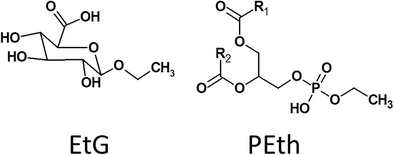Share this
VAMS meets PEth: changing the conversation around alcohol abuse
by Neoteryx Microsampling on Mar 22, 2019 3:51:00 AM

There are many situations or settings where it is necessary to screen people for alcohol consumption, including among organ transplant patients, those applying for a return of their suspended driver’s license, or those involved in child custody cases, and more.
Traditional alcohol screening methods involving hair or urine sampling have obvious and subtle drawbacks. Aside from the issue of a lack of specific or accurate results with these types of screens, traditional alcohol biomarkers can't always be used to make finer distinctions between social drinkers, heavy drinkers or alcoholics.
Phosphatidylethanol (PEth) is a more sensitive alcohol biomarker that can be detected in blood and is currently being studied by toxicology researcher Christophe Stove, PhD, and his team at Ghent University. PEth is already known to be a more advanced and specific way to measure alcohol use as compared to urine testing or other methods. Dr. Stove is investigating the variation at which PEth decreases in the bloodstream over the course of a month, to help improve and fine-tune this type of screening.
"We wanted to gain more insight into the behavior of PEth in people who normally drink alcohol, but at some point decide not to drink," says Stove. "Setting up a large-scale study like that is not very easy as it's quite complicated to find a large number of people that normally drink and then spontaneously decide not to drink for a month."
For that, he needed to recruit a large group of people who normally drink but were willing to abstain for a month. Dr. Stove made two decisions which made this much simpler.
He joined forces with Tournee Minerale, a month-long sobriety challenge well known in Belgium. He also took advantage of volumetric absorptive microsampling technology, in the form of Mitra® microsampling devices. The Mitra devices feature a special VAMS® tip that absorbs a precise volume of blood sufficient for lab analysis. Participants received Mitra devices at home in self-sampling kits. They were shown how to use the kits to easily collect their own dried specimens at different time points over the course of the month.
 Without VAMS, “there's no way that we would be able to recruit 800 study participants that would all need to come in for a blood draw at three time points in one month. That's huge. The recruitment of the participants definitely would not have been so easy. With VAMS, we could just tell them that they didn't need to leave their homes to participate. We sent the kits via regular mail and instructed them to sample themselves.”
Without VAMS, “there's no way that we would be able to recruit 800 study participants that would all need to come in for a blood draw at three time points in one month. That's huge. The recruitment of the participants definitely would not have been so easy. With VAMS, we could just tell them that they didn't need to leave their homes to participate. We sent the kits via regular mail and instructed them to sample themselves.”
The benefits of finger-prick capillary blood collection aren’t exclusive to research study participants.
“We have collaborated with centers that do follow-up for people who have had their driver's license suspended and need to get it back,” Stove said. “We asked the centers if they would consider a finger prick blood test as a possible option [for tracking a driver's sobriety.] They were quite enthusiastic about it. They considered [finger-stick blood sampling] more feasible because they could do that without the requirement of medically trained staff.”
Dr. Stove and his team are currently determining the results of the study. “The vast majority of the remote blood samples that we got back look good from a technical perspective,” Stove says. “We are busy with the analysis of these thousands of samples that we got back. In the next few months, we'll finish those analyses, and then we'll come out with the actual outcome of the study.”
 Even then, some issues around introducing PEth in the driving license regranting process must be overcome. For PEth measurement to gain widespread usage, a large majority of testing centers would need to agree to adopt microsampling and PEth analysis more or less simultaneously. If some centers start using PEth and others don't, "you would have some centers that are better at catching people that keep on drinking excessively, whereas other centers that would not use this alcohol biomarker would be worse at catching people that drink," Stove says.
Even then, some issues around introducing PEth in the driving license regranting process must be overcome. For PEth measurement to gain widespread usage, a large majority of testing centers would need to agree to adopt microsampling and PEth analysis more or less simultaneously. If some centers start using PEth and others don't, "you would have some centers that are better at catching people that keep on drinking excessively, whereas other centers that would not use this alcohol biomarker would be worse at catching people that drink," Stove says.
"The centers that would not use PEth would be, let's say, the interesting centers for the people that need to undergo testing."
Such are the challenges of process improvement for those working ahead of the curve.
As part of the work of cutting-edge organizations such as Ghent University, microsampling technologies are helping to advance health, wellness, and alcohol testing programs forward.

Image credits: Trajan, iStock
Share this
- Microsampling (206)
- Research, Remote Research (119)
- Venipuncture Alternative (105)
- Clinical Trials, Clinical Research (83)
- Mitra® Device (73)
- Therapeutic Drug Monitoring, TDM (51)
- Dried Blood Spot, DBS (39)
- Biomonitoring, Health, Wellness (30)
- Infectious Disease, Vaccines, COVID-19 (24)
- Blood Microsampling, Serology (23)
- Omics, Multi-Omics (21)
- Decentralized Clinical Trial (DCT) (20)
- Specimen Collection (18)
- Toxicology, Doping, Drug/Alcohol Monitoring, PEth (17)
- Skin Microsampling, Microbiopsy (14)
- hemaPEN® Device (13)
- Preclinical Research, Animal Studies (12)
- Pharmaceuticals, Drug Development (9)
- Harpera Device (7)
- Industry News, Microsampling News (5)
- Antibodies, MAbs (3)
- Company Press Release, Product Press Release (3)
- Environmental Toxins, Exposures (1)
- July 2025 (1)
- May 2025 (1)
- April 2025 (2)
- December 2024 (2)
- November 2024 (1)
- October 2024 (3)
- September 2024 (1)
- June 2024 (1)
- May 2024 (1)
- April 2024 (4)
- March 2024 (1)
- February 2024 (2)
- January 2024 (4)
- December 2023 (3)
- November 2023 (3)
- October 2023 (3)
- September 2023 (3)
- July 2023 (3)
- June 2023 (2)
- April 2023 (2)
- March 2023 (2)
- February 2023 (2)
- January 2023 (3)
- December 2022 (2)
- November 2022 (3)
- October 2022 (4)
- September 2022 (3)
- August 2022 (5)
- July 2022 (2)
- June 2022 (2)
- May 2022 (4)
- April 2022 (3)
- March 2022 (3)
- February 2022 (4)
- January 2022 (5)
- December 2021 (3)
- November 2021 (5)
- October 2021 (3)
- September 2021 (3)
- August 2021 (4)
- July 2021 (4)
- June 2021 (4)
- May 2021 (4)
- April 2021 (3)
- March 2021 (5)
- February 2021 (4)
- January 2021 (4)
- December 2020 (3)
- November 2020 (5)
- October 2020 (4)
- September 2020 (3)
- August 2020 (3)
- July 2020 (6)
- June 2020 (4)
- May 2020 (4)
- April 2020 (3)
- March 2020 (6)
- February 2020 (3)
- January 2020 (4)
- December 2019 (5)
- November 2019 (4)
- October 2019 (2)
- September 2019 (4)
- August 2019 (4)
- July 2019 (3)
- June 2019 (7)
- May 2019 (6)
- April 2019 (5)
- March 2019 (6)
- February 2019 (5)
- January 2019 (8)
- December 2018 (3)
- November 2018 (4)
- October 2018 (7)
- September 2018 (6)
- August 2018 (5)
- July 2018 (8)
- June 2018 (6)
- May 2018 (5)
- April 2018 (6)
- March 2018 (4)
- February 2018 (6)
- January 2018 (4)
- December 2017 (2)
- November 2017 (3)
- October 2017 (2)
- September 2017 (4)
- August 2017 (2)
- July 2017 (4)
- June 2017 (5)
- May 2017 (6)
- April 2017 (6)
- March 2017 (5)
- February 2017 (4)
- January 2017 (1)
- July 2016 (3)
- May 2016 (1)
- April 2016 (2)


Comments (1)